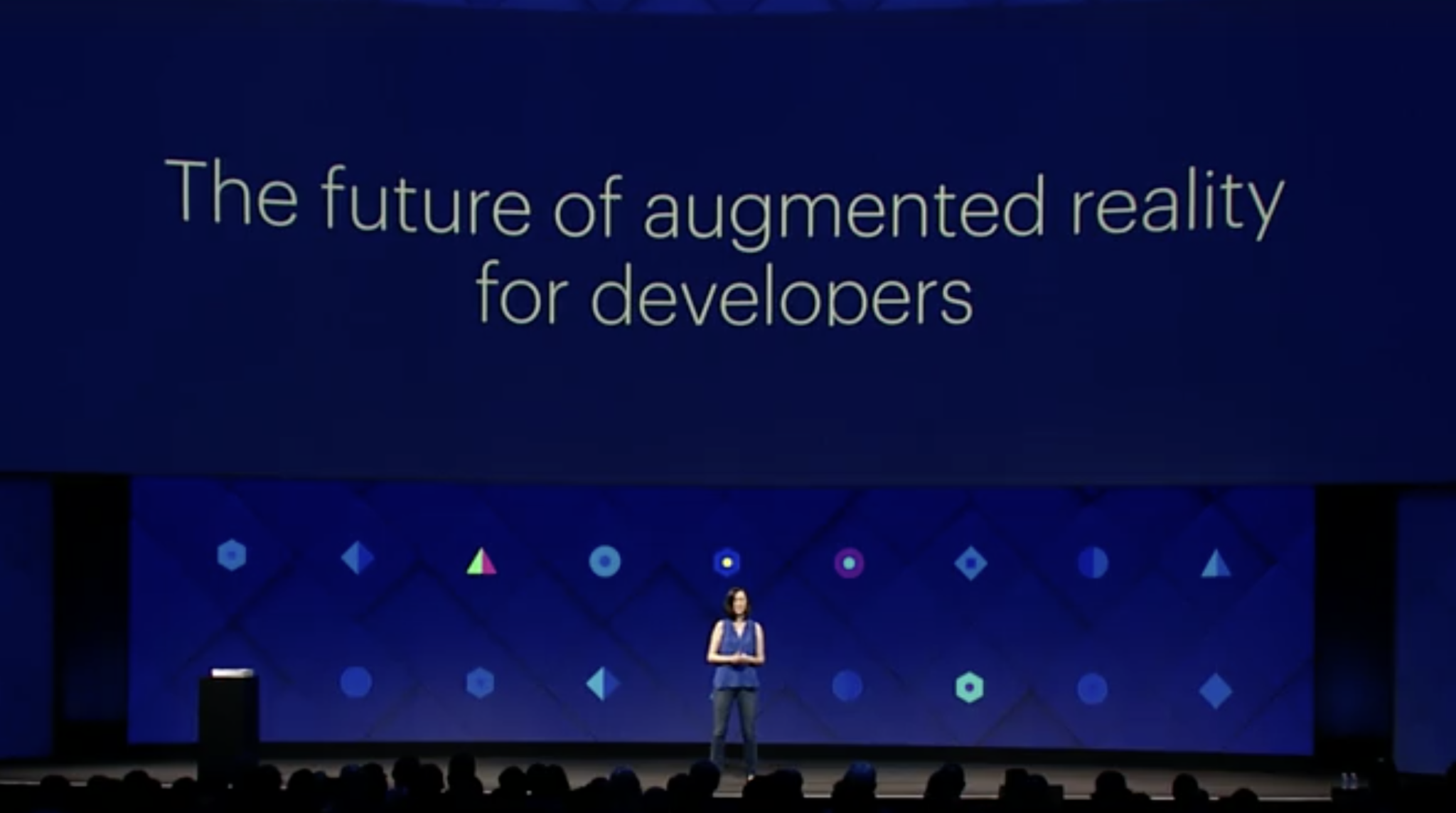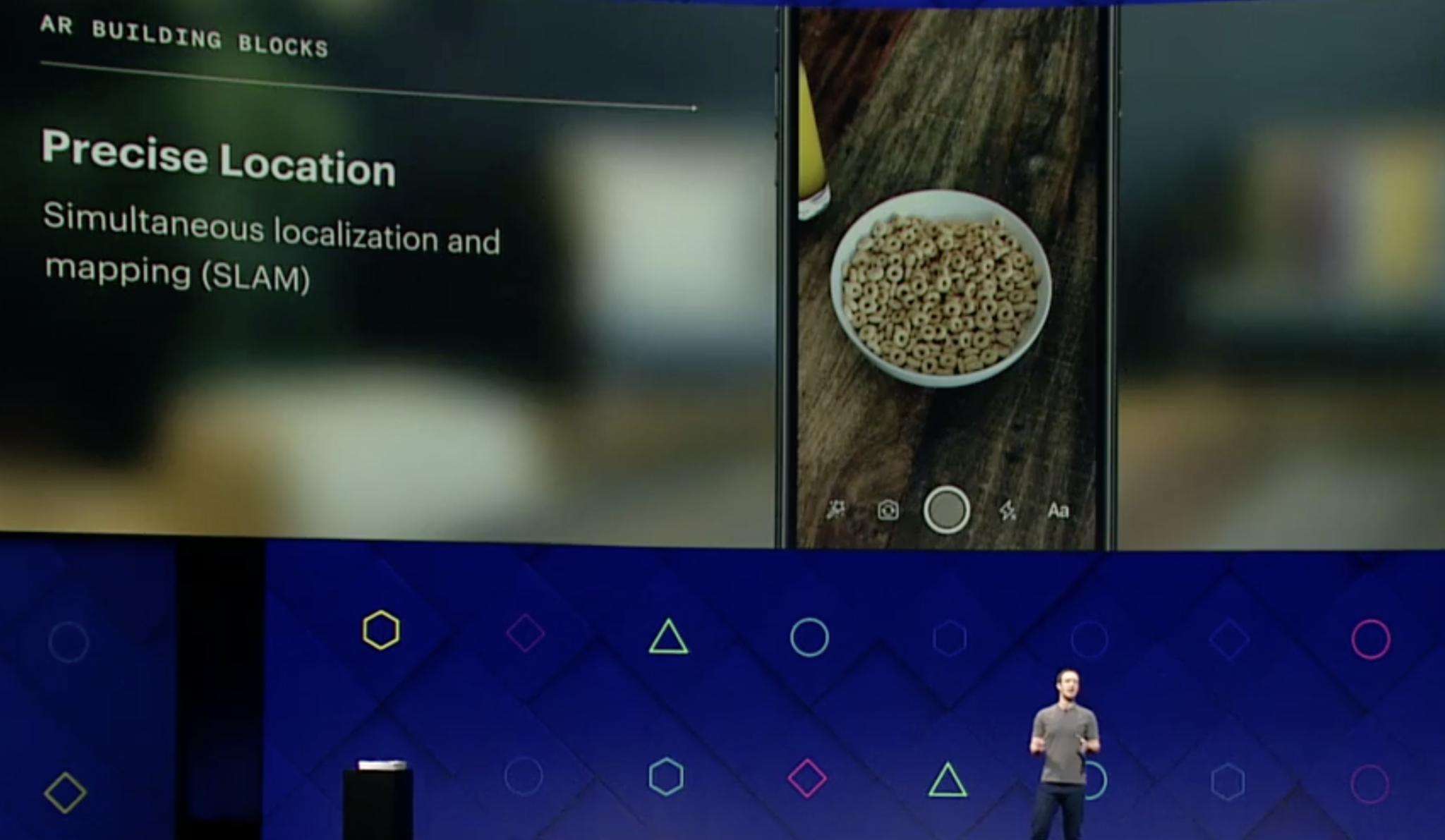[caption id="attachment_141086" align="aligncenter" width="2588"]

Facebook Camera Platform[/caption] “Even if we were a little slow to add cameras to all of our apps, I’m now confident that we’re going to put this technology forward.” With that, Facebook CEO Mark Zuckerberg, standing onstage at his company's annual developer conference (F8), launched a new augmented reality (AR) platform dubbed "Camera." Officially “Camera Effects,” Camera will still live inside of Facebook’s various apps such as Messenger, Instagram and Facebook proper. It has two main components: Frame Studio and AR Studio. Frame Studio is essentially picture frames for digital photos. Developers will be allowed to create special borders or overlays, which can be used for still images or videos. Live videos are also open for Frame Studio, which could add a bit of polish to live newscasts. AR Studio is where Facebook is putting most of its efforts. It’s also a bit experimental, just not in code. Facebook boldly
claims developers may be able to add AR effects without writing any code at all:
Many effects can be built without scripting or writing a single line of code. However, you can add more complex interactivity and animation with scripts, including bringing textures or data from outside sources into the scene, making art react to facial movements or taps, and connecting outside mobile apps directly to the camera for sharing.
Both components lean into SLAM, or Simultaneous Location and Mapping. It’s what allows the camera to consider layers, identify people and objects, and keep filters related to objects. In one fell swoop, SLAM knows your hand is two feet from the camera, and the Grand Canyon is far deeper than it looks in 2D; if you were to ‘toss’ a digital icon into the Grand Canyon, SLAM would be the technology that puts it on a realistic line and makes it smaller as it ‘falls’ to add a layer of context to the scene. [caption id="attachment_141087" align="aligncenter" width="2236"]

Facebook SLAM[/caption] Currently in a closed beta period, Facebook’s AR Studio was on full display at F8. As Zuckerberg noted, the studio is first opening up for social use-cases, with gaming to follow. He opined on a great many reasons that developers should use AR in their apps; for example, tagging a location with a review that people walking by will see on-screen, or leaving digital notes for friends. (Zuckerberg’s example involved leaving a digital Post-it for your significant other on the refrigerator at home.) In admitting that it’s early days for the program, Facebook isn’t expecting that developers will have experiences ready for users soon. But it’s pretty easy to see where this is going: platforms mean monetization. Like Messenger, Facebook is clearly going to make Camera a platform developers can make money on. It also steps right on Snapchat’s toes. That company currently makes money from geofilters or special event stickers. Facebook took that model and opened it up to the developer community. Instead of raking in tens of thousands from unique apps, it just asks for a cut of what developers charge. This will all happen on a smartphone, too. As Zuckerberg noted, we shouldn’t need a “$500 gadget” to experience AR. That’s a shot at virtual reality (VR), where Facebook hung its hat as recently as last year’s F8. It’s possible that VR just isn’t taking off as the company imagined, even as it announced that its new VR-based social effort, Spaces, was launching today. With Spaces, you can experience other locations virtually, with friends, and even make VR calls via Messenger to friends who don’t have a VR headset. They’ll see what you see, but the environment won’t be immersive for them. It’s either potentially sensational, or nightmarish – we can’t tell yet. But what we do see with this year's F8 is Facebook at a crossroads. VR and AR are not the same thing, and it’s becoming clear that the population at large will be moving toward AR. VR will, possibly forever, remain a niche category for power users. As a platform, Camera is an obfuscation layer. Users don’t need a separate app to download it; it lives in each Facebook product they touch, anyway. That’s positive. On the downside, we can’t say
how users will know to activate that Camera feature in their Facebook app suite to experience features – or if it matters. We also wonder if Camera will support embedding in third-party apps. Once the ‘future’ of the company, VR now feels like a moonshot that isn’t playing out as planned. AR is new for Facebook, but the Camera platform is ahead of the curve. (It might be a hint at what Apple has planned for WWDC, too, where many expect it will launch
some sort of AR platform.)
 Facebook Camera Platform[/caption] “Even if we were a little slow to add cameras to all of our apps, I’m now confident that we’re going to put this technology forward.” With that, Facebook CEO Mark Zuckerberg, standing onstage at his company's annual developer conference (F8), launched a new augmented reality (AR) platform dubbed "Camera." Officially “Camera Effects,” Camera will still live inside of Facebook’s various apps such as Messenger, Instagram and Facebook proper. It has two main components: Frame Studio and AR Studio. Frame Studio is essentially picture frames for digital photos. Developers will be allowed to create special borders or overlays, which can be used for still images or videos. Live videos are also open for Frame Studio, which could add a bit of polish to live newscasts. AR Studio is where Facebook is putting most of its efforts. It’s also a bit experimental, just not in code. Facebook boldly claims developers may be able to add AR effects without writing any code at all:
Facebook Camera Platform[/caption] “Even if we were a little slow to add cameras to all of our apps, I’m now confident that we’re going to put this technology forward.” With that, Facebook CEO Mark Zuckerberg, standing onstage at his company's annual developer conference (F8), launched a new augmented reality (AR) platform dubbed "Camera." Officially “Camera Effects,” Camera will still live inside of Facebook’s various apps such as Messenger, Instagram and Facebook proper. It has two main components: Frame Studio and AR Studio. Frame Studio is essentially picture frames for digital photos. Developers will be allowed to create special borders or overlays, which can be used for still images or videos. Live videos are also open for Frame Studio, which could add a bit of polish to live newscasts. AR Studio is where Facebook is putting most of its efforts. It’s also a bit experimental, just not in code. Facebook boldly claims developers may be able to add AR effects without writing any code at all:
 Facebook SLAM[/caption] Currently in a closed beta period, Facebook’s AR Studio was on full display at F8. As Zuckerberg noted, the studio is first opening up for social use-cases, with gaming to follow. He opined on a great many reasons that developers should use AR in their apps; for example, tagging a location with a review that people walking by will see on-screen, or leaving digital notes for friends. (Zuckerberg’s example involved leaving a digital Post-it for your significant other on the refrigerator at home.) In admitting that it’s early days for the program, Facebook isn’t expecting that developers will have experiences ready for users soon. But it’s pretty easy to see where this is going: platforms mean monetization. Like Messenger, Facebook is clearly going to make Camera a platform developers can make money on. It also steps right on Snapchat’s toes. That company currently makes money from geofilters or special event stickers. Facebook took that model and opened it up to the developer community. Instead of raking in tens of thousands from unique apps, it just asks for a cut of what developers charge. This will all happen on a smartphone, too. As Zuckerberg noted, we shouldn’t need a “$500 gadget” to experience AR. That’s a shot at virtual reality (VR), where Facebook hung its hat as recently as last year’s F8. It’s possible that VR just isn’t taking off as the company imagined, even as it announced that its new VR-based social effort, Spaces, was launching today. With Spaces, you can experience other locations virtually, with friends, and even make VR calls via Messenger to friends who don’t have a VR headset. They’ll see what you see, but the environment won’t be immersive for them. It’s either potentially sensational, or nightmarish – we can’t tell yet. But what we do see with this year's F8 is Facebook at a crossroads. VR and AR are not the same thing, and it’s becoming clear that the population at large will be moving toward AR. VR will, possibly forever, remain a niche category for power users. As a platform, Camera is an obfuscation layer. Users don’t need a separate app to download it; it lives in each Facebook product they touch, anyway. That’s positive. On the downside, we can’t say how users will know to activate that Camera feature in their Facebook app suite to experience features – or if it matters. We also wonder if Camera will support embedding in third-party apps. Once the ‘future’ of the company, VR now feels like a moonshot that isn’t playing out as planned. AR is new for Facebook, but the Camera platform is ahead of the curve. (It might be a hint at what Apple has planned for WWDC, too, where many expect it will launch some sort of AR platform.)
Facebook SLAM[/caption] Currently in a closed beta period, Facebook’s AR Studio was on full display at F8. As Zuckerberg noted, the studio is first opening up for social use-cases, with gaming to follow. He opined on a great many reasons that developers should use AR in their apps; for example, tagging a location with a review that people walking by will see on-screen, or leaving digital notes for friends. (Zuckerberg’s example involved leaving a digital Post-it for your significant other on the refrigerator at home.) In admitting that it’s early days for the program, Facebook isn’t expecting that developers will have experiences ready for users soon. But it’s pretty easy to see where this is going: platforms mean monetization. Like Messenger, Facebook is clearly going to make Camera a platform developers can make money on. It also steps right on Snapchat’s toes. That company currently makes money from geofilters or special event stickers. Facebook took that model and opened it up to the developer community. Instead of raking in tens of thousands from unique apps, it just asks for a cut of what developers charge. This will all happen on a smartphone, too. As Zuckerberg noted, we shouldn’t need a “$500 gadget” to experience AR. That’s a shot at virtual reality (VR), where Facebook hung its hat as recently as last year’s F8. It’s possible that VR just isn’t taking off as the company imagined, even as it announced that its new VR-based social effort, Spaces, was launching today. With Spaces, you can experience other locations virtually, with friends, and even make VR calls via Messenger to friends who don’t have a VR headset. They’ll see what you see, but the environment won’t be immersive for them. It’s either potentially sensational, or nightmarish – we can’t tell yet. But what we do see with this year's F8 is Facebook at a crossroads. VR and AR are not the same thing, and it’s becoming clear that the population at large will be moving toward AR. VR will, possibly forever, remain a niche category for power users. As a platform, Camera is an obfuscation layer. Users don’t need a separate app to download it; it lives in each Facebook product they touch, anyway. That’s positive. On the downside, we can’t say how users will know to activate that Camera feature in their Facebook app suite to experience features – or if it matters. We also wonder if Camera will support embedding in third-party apps. Once the ‘future’ of the company, VR now feels like a moonshot that isn’t playing out as planned. AR is new for Facebook, but the Camera platform is ahead of the curve. (It might be a hint at what Apple has planned for WWDC, too, where many expect it will launch some sort of AR platform.) 

